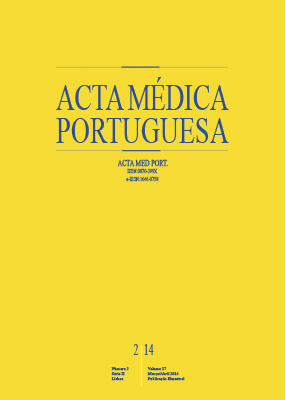First-Trimester Biochemical Markers and Small-for-Gestational-Age Infants
DOI:
https://doi.org/10.20344/amp.3985Abstract
Introduction: Several studies suggested an association between first trimester biochemical markers (PAPP-A and β- HCG) and infants below 10th percentile. Our goal was to describe this relationship of biochemical markers with small-for- gestational-age fetuses in our population.Material and Methods: Retrospective analytic study of 2 035 pregnant women that underwent first-trimester screening in the period between March 2009 and September 2011. Small-for-gestational-age infants below 10th percentile were compared with control group (term newborn with birth weight above 10th percentile). Infants below 3rd percentile and control group were also compared. Multiple and logistic regression analysis were done with PAPP-A, β-HCG (multiples of the expected normal median) and demographic maternal characteristics (ethnicity, weight and smoker status).
Results: This study demonstrated an independent contribution of PAPP-A, maternal weight and smoker status in predicting small-for-gestational-age infants. For PAPP-A, the odds ratio for small-for-gestational age below 10th and 3rd percentile was 2.41 and 3.41, respectively (p < 0.01). For β-HCG, odds ratio below 10th percentile was 1.70 (p = 0.03) and for birth weight below the 3rd percentile, the odds ratio was 3.22 (p < 0.01).
Conclusions: Low levels of PAPP-A and β-HCG (values below 5th percentile of the study population) were associated with an increased risk of small-for-gestational-age infants in the pregnant population included in this study.
Downloads
Downloads
Published
How to Cite
Issue
Section
License
All the articles published in the AMP are open access and comply with the requirements of funding agencies or academic institutions. The AMP is governed by the terms of the Creative Commons ‘Attribution – Non-Commercial Use - (CC-BY-NC)’ license, regarding the use by third parties.
It is the author’s responsibility to obtain approval for the reproduction of figures, tables, etc. from other publications.
Upon acceptance of an article for publication, the authors will be asked to complete the ICMJE “Copyright Liability and Copyright Sharing Statement “(http://www.actamedicaportuguesa.com/info/AMP-NormasPublicacao.pdf) and the “Declaration of Potential Conflicts of Interest” (http:// www.icmje.org/conflicts-of-interest). An e-mail will be sent to the corresponding author to acknowledge receipt of the manuscript.
After publication, the authors are authorised to make their articles available in repositories of their institutions of origin, as long as they always mention where they were published and according to the Creative Commons license.









